Discovering Ji1 Diamonds: Characteristics and Value
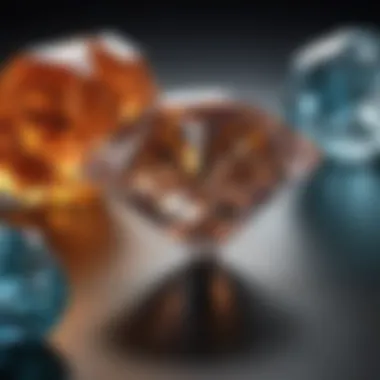
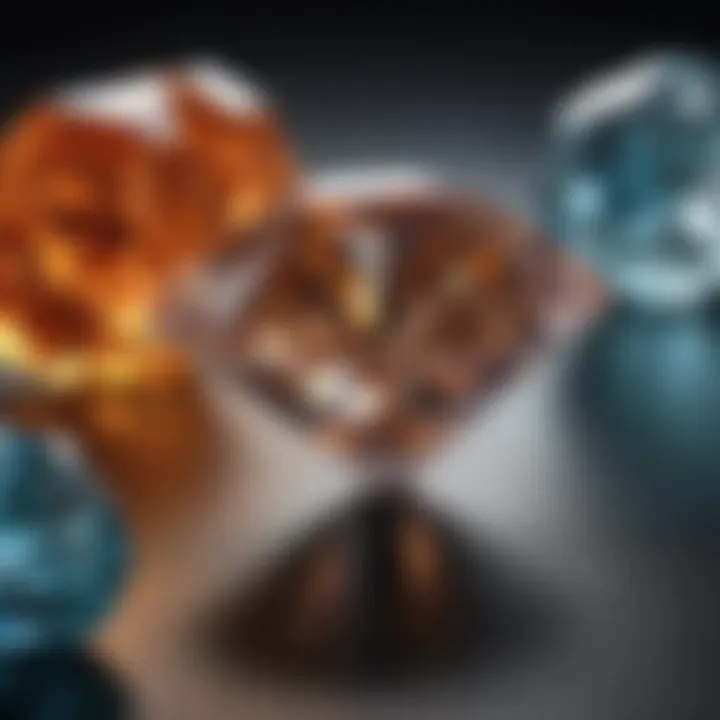
Intro
In a realm where gemstones captivate hearts and command prices, Ji1 diamonds stand out as a stunning marvel of nature. Known for their alluring brilliance and unique characteristics, these diamonds offer a wealth of intrigue and significance. As we delve into the fascinating world of Ji1 diamonds, we unveil their formation, properties, and place among other gemstones.
Gemstone Overview
Definition and characteristics
Ji1 diamonds represent a specific classification within the broader spectrum of diamonds. Characterized by distinct traits, these diamonds possess a clarity and sparkle that sets them apart from their counterparts. Often found in hues that range from the purest whites to subtle shades, their visual appeal is matched only by their rarity.
Classification of gemstones
Gemstones, in general, are categorized based on various criteria such as composition, hardness, and origin. Ji1 diamonds fall under the category of natural diamonds, which are formed deep within the Earth under immense pressure and heat over millions of years. This classification places them in an elite lineage that includes other well-known diamonds, like the illustrious Cullinan and Hope diamonds.
- Natural Diamonds: Formed through natural processes.
- Synthetic Diamonds: Created in labs, mimicking natural conditions.
- Fancy Color Diamonds: Those with rich colors aside from traditional clear.
As we explore these concepts, it’s crucial to discern Ji1 diamonds from other classifications to truly appreciate their unique beauty and value.
Properties of Gemstones
Physical properties
The allure of Ji1 diamonds begins with their physical makeup. They exhibit exceptional hardness, rated 10 on the Mohs scale, making them one of the most durable substances known. This durability is not merely for show; it adds practical value, as they resist scratching and damage effectively. Also noteworthy is their light refractivity, which contributes to the captivating sparkle that draws many toward them.
- Hardness: 10 (Mohs Scale)
- Refractive Index: Approximately 2.42
- Specific Gravity: Ranges from 3.5 to 3.53
Chemical properties
The chemical composition of Ji1 diamonds primarily consists of carbon atoms arranged in a crystal lattice structure. This unique atomic configuration gives rise to their exceptional hardness and thermal conductivity. Understanding these properties can enhance one’s appreciation not just of Ji1 diamonds, but of diamonds as a whole.
"The beauty of Ji1 diamonds is not just skin deep; it extends into their composition and formation, bridging nature and artistry."
The chemical stability of diamonds makes them low-maintenance, an appealing characteristic for collectors and enthusiasts. However, certain environmental factors, like extreme heat or chemical exposure, can impact their surface and brilliance.
As we continue our journey through the world of Ji1 diamonds, let's address more about their sourcing practices, historical significance and the crucial aspects that make them a prized possession for jewelry designers and collectors alike.
Prolusion to Ji1 Diamonds
When one hears the term "Ji1 diamonds," what often springs to mind is their exquisite beauty and rarity. Yet, it’s crucial to delve deeper into what truly sets these diamonds apart in the vast world of gemstones. This section aims to paint a clear picture of Ji1 diamonds, shedding light on their importance not just as a luxury item but also as a significant player in the broader gemstone market.
For enthusiasts, collectors, and jewelry designers, understanding the nuances of Ji1 diamonds can unlock a realm of appreciation that transcends mere aesthetics. The beauty of these diamonds goes beyond the surface; it lies in their unique formation process and remarkable properties that give them their distinctive identity.
The importance of Ji1 diamonds can be summed up in several key aspects:
- Rarity and Demand: Ji1 diamonds, when compared to more common diamond types, possess a unique blend of attributes that contribute to their speculative and investment potential. This rarity sparks intrigue among collectors who appreciate not only the gem's beauty but also its market viability.
- Rich Storytelling: Each Ji1 diamond carries with it a story of geological processes that shape its very essence. These narratives resonate with buyers who are increasingly seeking more than just a beautiful item; they want an investment with history.
- Cultural Significance: As symbols of love, fidelity, and status, Ji1 diamonds occupy a crucial position in various cultures. They embody traditions and values that have evolved over centuries, making them a focal point for both personal and collective significance in contemporary society.
- Innovative Craftsmanship: The journey of Ji1 diamonds from rough stones to stunning jewelry reflects not just artistic expression but also technological advancements in gem-cutting and designing techniques. This intersection of art and science is particularly appealing to jewelry designers eager to push the boundaries of creativity.
According to a report I came across, the craftsmanship and finishing touches applied to Ji1 diamonds can sometimes make all the difference in how they are perceived in the market. This speaks volumes about the importance of selecting high-quality stones and the skill involved in their crafting.
"Diamonds are a girl's best friend, but Ji1 diamonds are an artist’s canvas."
Defining Ji1 Diamonds
Understanding what Ji1 diamonds are is fundamental for anyone diving into the intricate domain of gemstones. This article aims to demystify the characteristics that set Ji1 diamonds apart from their counterparts and underscore the significance of their definition within the gemstone community. With a growing interest in unique diamonds like Ji1, knowing their defining aspects can enhance one’s appreciation for them as not just ornaments but as remarkable geological formations.
Chemical Composition
Ji1 diamonds boast a unique chemical composition that primarily consists of carbon, just like most natural diamonds. However, their formation often results in distinctive microstructures and impurities, giving them qualities that can be fascinatingly different.
There are traces of other elements in Ji1 diamonds, such as nitrogen and boron, which can affect their color. Nitrogen can introduce a yellowish tint, while boron traces often give a stunning blue hue. The specific chemical marker that designates a diamond as Ji1 lies in its purity levels and trace elements. The research into this composition opens pathways for further inquiry.
Additionally, unlike conventional diamonds, Ji1 diamonds may hold up to the scrutiny of advanced spectroscopic analysis, allowing gemologists to unveil more about their formation process and geographical origin. These scientific approaches are not just academic; they serve practical purposes in assessing the diamond's quality and authenticity.
Physical Properties
When talking about physical properties, Ji1 diamonds exhibit intriguing characteristics that could grab any gem lover's attention. One of the most striking physical properties is their exceptional hardness, rated at 10 on the Mohs scale, the highest a mineral can achieve. This makes Ji1 diamonds suitable for engagement rings and everyday wear, as they resist scratches and maintain their brilliance.
Another property worth mentioning is the diamond’s scintillation—this refers to the way light interacts with the diamond's facets to create a dazzling display. The intricate cuts and craftsmanship elevate the Ji1 diamond, making it not just a geological specimen but a work of art.
Moreover, Ji1 diamonds can have an array of colors and clarity levels. Color grades can range from colorless to light yellow or brown, while clarity ratings describe the presence of inclusions or blemishes. A Ji1 diamond's clarity can significantly affect its value, with higher clarity often fetching premium prices in the market.
In summary, understanding the chemical makeup and physical qualities of Ji1 diamonds can provide valuable insights into their uniqueness. These characteristics are crucial for collectors, connoisseurs, and anyone interested in the intricate world of gemstones.
The Formation of Diamonds
The formation of diamonds is a fundamental aspect of understanding these precious gemstones, particularly Ji1 diamonds. This section delves into the geological processes and time scales necessary for diamond formation, revealing how these exquisite stones transcend mere beauty to embody a rich tapestry of earth's history. Knowing how diamonds form can inform both collectors and jewelers alike, providing insights that deepen appreciation and foster responsible practices in the trade.
Geological Processes
Diamonds, including Ji1 diamonds, are primarily formed deep within the Earth, approximately 150 to 200 kilometers beneath the surface. This region, known as the mantle, is where the high pressure and temperature conditions create the perfect environment for carbon atoms to crystallize into the structure we recognize as diamonds.
The processes involved in their formation can be broken down into a few key stages:
- Carbon Source: The carbon needed to create diamonds can originate from subducted oceanic plates or even organic materials from the Earth’s crust.
- Extreme Conditions: The intense pressure and high temperatures—often exceeding 1,000 degrees Celsius and pressures around 3 GPa—facilitate the crystallization of carbon.
- Transport to Surface: Volcanic eruptions typically bring diamonds closer to the Earth's surface via a unique type of magma called kimberlite. This magma cools and solidifies, potentially carrying diamonds along for the ride.
These geological processes underscore how Ji1 diamonds are not merely found but are birthed over eons, making them a testament to Earth’s natural history.
Time Scales of Formation
When discussing the formation of Ji1 diamonds, it is essential to recognize that this is not an overnight process but one that unfolds over vast lengths of time. The formation of diamonds can span millions to billions of years.
From the moment carbon enters the mantle until the eventual eruption that exposes diamonds at the surface, several factors play a role:
- Natural Erosion: Elements like wind and water slowly erode surface rock, potentially exposing kimberlite pipes containing diamonds.
- Continental Drift: Over millions of years, movements of tectonic plates can shift diamonds from one location to another.
- Human Discovery: After reaching the surface, it may take significant time before humans discover these gems.
"Diamonds are not just rocks; they are the Earth's legacy, forged in fire and time."
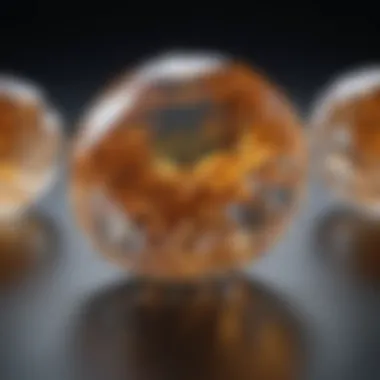
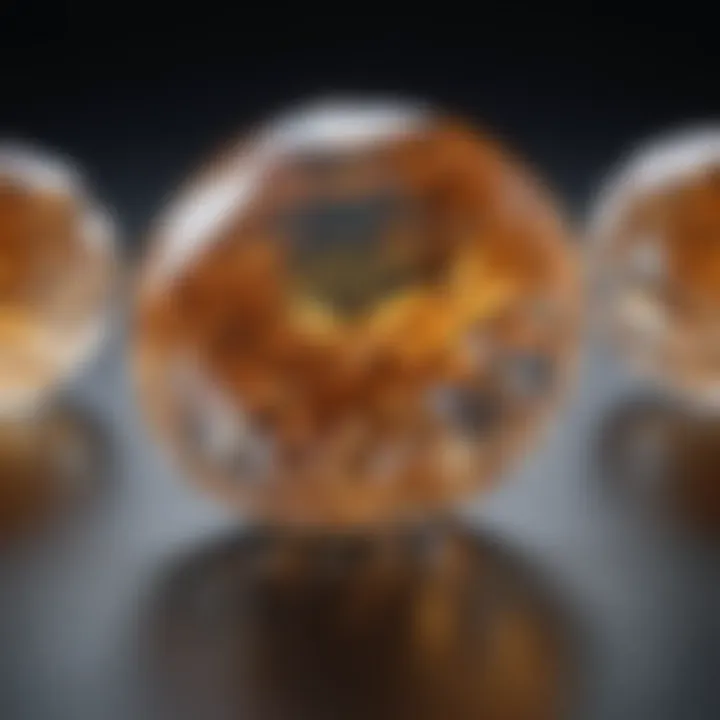
The lengthy time scales involved in diamond formation accentuate their rarity and value, especially for Ji1 diamonds. Each stone tells a story that spans epochs, connecting us to the deep past of the planet.
Understanding how diamonds form equips collectors and enthusiasts with the knowledge to value their gems not just for their aesthetic appeal but for the rich geological journey they represent. In the context of Ji1 diamonds, it highlights their exclusivity and the environmental history that shapes them.
Distinction Between Ji1 Diamonds and Other Diamonds
Understanding the differences between Ji1 diamonds and their counterparts is essential for anyone venturing into the world of gemstones. The intricacies that set apart Ji1 diamonds are not just vital in distinguishing one type from another, but they also play a significant role in determining their value, appeal, and appropriate applications in jewelry design. As collectors and enthusiasts delve deeper into this niche, recognizing these distinctions can enhance appreciation and inform purchasing decisions.
Color Grades and Clarity Ratings
Color and clarity are two critical aspects of diamond evaluation. Ji1 diamonds often display a unique range of hues and clarity levels, setting them apart from other diamonds. Though Ji1 diamonds might differ in sight from standard diamonds, they are only graded based on the GIA or AGS scale.
- Color Grades
Ji1 diamonds typically hide a captivating color palette. Unlike traditional diamonds, which focus primarily on whiteness or slight tints, Ji1 diamonds can range from faint shades to bold colors. The grading scale generally categorizes them from D (colorless) to Z (light yellow or brown), but many Ji1 diamonds shine brightly with vivid colors, often fetching a higher price. - Clarity Ratings
Clarity ratings reflect the presence of inclusions or blemishes. Ji1 diamonds often present intriguing inclusions that tell stories of their formation. While traditional clarity grading leans heavily towards flawlessness, enthusiasts regard some inclusions in Ji1 diamonds as part of their unique charm. These characteristics can appeal greatly to collectors who value the narrative each gem carries.
Cut and Craftsmanship
The cut of a diamond brings forth its brilliance, and the craftsmanship behind Ji1 diamonds deserves a closer look.
- Precision Cut
A well-executed cut enhances the innate beauty of Ji1 diamonds. The angles and proportions are pivotal in letting light dance through the stone. Unlike standard cuts that often follow classic shapes like round or princess, Ji1 diamonds sometimes find themselves in more unconventional shapes. These imaginative cuts can yield exceptional light performance, bringing out a stone's best attributes. - Artisanal Craftsmanship
The artistry involved in crafting Ji1 diamonds plays a noteworthy role in their distinction. Many of these diamonds emerge from jewelers who believe in the soul of craftsmanship, employing techniques passed down through generations. When a Ji1 diamond is cut, it’s not solely about the shape but also about the story behind the piece. Some cuts might intentionally incorporate design features that reflect cultural significance or respond to contemporary trends. The unique touch of skilled artisans can bring a higher demand among collectors who appreciate the combination of beauty and artistry.
"A well-cut Jin diamond doesn’t just shine; it tells a story of skill, craftsmanship, and history."
Understanding these aspects enables buyers to make informed decisions, ensuring their piece resonates not just with their aesthetic appeal, but also with its intrinsic value and history.
Cultural Significance of Ji1 Diamonds
Understanding the cultural significance of Ji1 diamonds is crucial in grasping why they hold such an esteemed place in both historical and contemporary contexts. Far beyond their physical beauty, these gems carry deep meanings that echo through time and resonate in modern society. When we examine the intricate tapestry that Ji1 diamonds are woven into, we can appreciate their multifaceted role as symbols of wealth, power, and emotional connections.
Historical Trends
Historically, Ji1 diamonds have been linked with royalty and the elite. Different cultures have placed immense value on these stones, often viewing them as representative of divine favor. For instance, in ancient India, diamonds were believed to possess protective qualities, ensuring safe travels and warding off negativity. They were also thought to enhance bravery, making them a favored choice among warriors. The diamond's indestructibility echoed strength in various civilizations.
As centuries progressed, the allure of Ji1 diamonds only grew. They became intertwined with significant life events, like engagements and weddings, solidifying their status as tokens of love and commitment. The famous Hope Diamond, though now a part of museum collections, exemplifies how a diamond can encapsulate history, legend, and value.
In certain European cultures, diamonds became synonymous with power and influence during the Renaissance period. They adorned crowns and sceptres, reflecting the wealth and stature of their owners. This historical backdrop sets a captivating stage for understanding the modern implications of owning a Ji1 diamond.
Contemporary Symbolism
Today, Ji1 diamonds symbolize more than just luxury; they represent enduring love and significant milestones in life. Their role in engagement rings is one such example, where a diamond signifies a promise of fidelity and a shared future. They encapsulate important life moments—from graduations to anniversaries—marking transitions with elegance and significance.
Moreover, in contemporary art and fashion, Ji1 diamonds have found new life. Designers incorporate them into pieces that challenge the norms of beauty and wealth. For some, wearing Ji1 diamonds means making a statement about one's values, whether related to sustainability or ethical sourcing.
Their representation in popular media also influences public perception. From film depictions that romanticize diamond ownership to social media trends showcasing their beauty, Ji1 diamonds remain vibrant symbols in the public eye, sparking conversations about desire, aspiration, and sometimes, the ethical implications of diamond mining.
Many in modern society are turning to Ji1 diamonds not just for their beauty, but for what they represent. They embody a connection to heritage, personal stories, and contemporary notions of self-expression.
"Diamonds are not just gems; they're narratives of culture, expressing everything from love to artistic ambition."
In summary, the cultural significance of Ji1 diamonds is rich with layers of meaning. As they weave through history, embedding themselves in the fabric of life’s milestones and modern expressions, they remind us that these stunning stones are more than mere objects; they are repositories of human experience and aspiration.
Ethical Sourcing of Diamonds
Ethical sourcing is a fundamental element in the discussion surrounding diamonds, especially when it comes to Ji1 diamonds. As consumers become more aware, the demand for diamonds that are not just beautiful but are also sourced responsibly is on the rise. Ethical sourcing addresses the origins of these precious stones, ensuring that the extraction and sale process does not contribute to conflict, human rights abuses, or environmental degradation. By understanding this context, we empower ourselves to make informed choices that reflect our values.
Understanding Conflict Diamonds
Conflict diamonds, often termed "blood diamonds," are gems extracted from war zones and sold to finance armed conflict against governments. These diamonds typically come at a horrific human cost, with many workers subjected to inhumane conditions, forced labor, and violence. The situation highlights a critical issue in the diamond industry, particularly concerning safety and ethical standards. Awareness has prompted many organizations to advocate for stricter regulations and certification processes.
"Diamonds should sparkle with love, not blood."
The Kimberley Process was established in 2003 in response to this crisis, aiming to prevent the trade in conflict diamonds. It requires participating countries to certify the origin of their diamonds and ensure they are conflict-free. Nevertheless, its effectiveness has been questioned, as loopholes still allow some conflict diamonds to enter the market unnoticed. Consumers play an essential role by demanding transparency and accountability from dealers, encouraging the industry to adopt more stringent measures against unethical practices.
Sustainable Practices in the Diamond Industry
Sustainability has emerged as a key principle in the modern diamond industry, and many brands are actively working to mitigate their environmental impact. Sustainable practices cover several areas, including:
- Eco-Friendly Mining Techniques: These aim to protect ecosystems and minimize environmental disruption during diamond extraction. For instance, some companies are focusing on alluvial mining, a less invasive method of extraction that reduces soil erosion and habitat destruction.
- Carbon Offset Programs: Some jewelers contribute to carbon offset initiatives, investing in planting trees or supporting renewable energy projects to balance out the carbon emissions generated during the diamond mining process.
- Fair Trade Policies: Similar to food and coffee, diamonds too can be traded under fair trade principles. This means that gem workers receive fair wages and work in safe conditions, ultimately leading to better livelihoods.
- Lab-Grown Diamonds: These options are gaining traction. Lab-grown diamonds are created using technology that mimics natural processes and often have lower environmental impacts compared to traditional mining. They offer a transparent origin story, as they're not linked to conflict or labor exploitation.
To ensure you're purchasing responsibly, it's critical to seek out reputable jewelers who can provide information about the sourcing of their diamonds. Look for certifications or partnerships with organizations dedicated to promoting ethical mining practices.
Evaluating Ji1 Diamonds
When it comes to Ji1 diamonds, understanding their qualities and market position is crucial for both enthusiasts and investors alike. Evaluation plays a critical role in determining their true value, ensuring that buyers and sellers are well-informed about what they possess or desire. In the end, an informed decision can result in securing a jewel that not only dazzles but also holds its worth over time, especially against the backdrop of changing trends in the gemstone market.
Appraisal Criteria
Evaluating Ji1 diamonds involves assessing several key factors. Each element contributes to how a diamond is perceived and priced in the marketplace. Here are some essential criteria that should be considered:
- Cut Quality: The way a Ji1 diamond is cut significantly affects its brilliance and sparkle. A well-executed cut reflects light beautifully, drawing attention to the diamond's innate qualities. A diamond can be considered excellent, good, or fair, depending on the precision of the cut.
- Clarity: This refers to the presence of internal characteristics, known as inclusions, or surface blemishes. A Ji1 diamond with fewer imperfections tends to be rarer and command a higher price. Evaluating clarity can be complex; hence, professionals often use magnification tools during the appraisal process.
- Color: Ji1 diamonds usually possess a distinctive color spectrum. In general, vibrant colors often fetch a premium. The color grading scale moves from D (colorless) to Z (light yellow or brown), indicating the range of hues and their impact on a diamond's desirability.
- Carat Weight: Often, the heftier the diamond, the more it is valued. However, larger carat weights need to harmonize with the other qualities to maintain a balanced value. For instance, a smaller diamond of exceptional clarity could be considered more valuable than a larger stone with numerous flaws.
Evaluators often utilize certification from authoritative bodies like the Gemological Institute of America (GIA) to formally assess these aspects. Such certifications also add credibility when presenting a diamond in the market.
Market Value Assessment
Market value assessment adds another layer of understanding in the evaluation process, steering the buyer or seller towards making more strategic decisions. There are several notable components to consider:
- Supply and Demand: The availability of Ji1 diamonds in relation to market demand can significantly influence their pricing. A sudden increase in interest, perhaps driven by evolving fashion trends or buzz in social media, can cause an uptick in value. Conversely, an oversupply could push prices down.
- Market Trends: Staying up-to-date with market trends influences valuation as well. There are rising movements towards sustainability, and diamonds sourced ethically may attract premium pricing. Understanding these trends can help forecast how Ji1 diamonds will hold or increase their value over time.
- Comparative Analysis: Looking at similar diamonds in the market allows appraisers to gauge appropriate pricing. Online auction platforms or jewelers often provide a gold mine of data to compare similar gems, yielding insight into realistic market value.
- Historical Significance: If a diamond carries historical or cultural significance, it often adds to its appeal and market value. A Ji1 diamond that has been passed down through generations or tied to a noteworthy event may command a premium.
"The true value of a diamond is not merely in its weight or clarity, but in the stories it holds, the moments it symbolizes, and the joy it brings to life."
Care and Maintenance of Ji1 Diamonds
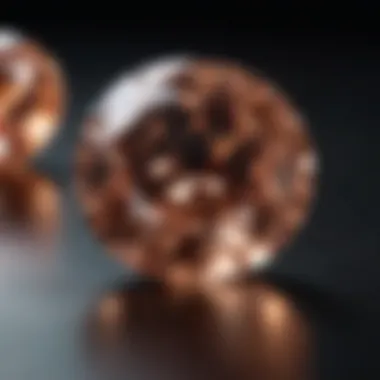
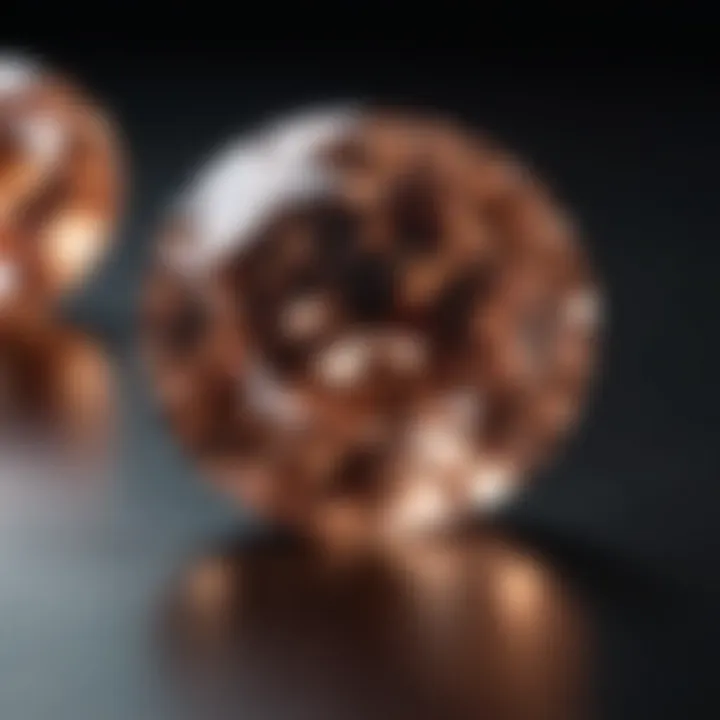
Caring for Ji1 diamonds goes beyond aesthetic appreciation; it ensures the longevity and sparkle of these precious stones. A well-maintained diamond not only retains its visual beauty but also its value, making proper care a critical consideration. Understanding effective cleaning and storage practices can substantially influence a collector's experience and investment outcomes.
Cleaning Techniques
Keeping Ji1 diamonds clean is essential for maintaining their brilliance. The presence of dirt, oils, and other residues can hinder their natural sparkle. Here are some effective methods for maintaining diamond luster:
- Gentle Soap and Water Solution: Mix a few drops of liquid soap in lukewarm water. Soak the diamond jewelry for about 15 minutes and gently scrub using a soft toothbrush, focusing on crevices where dirt often hides.
- Ammonia Solution: For deeper cleaning, a solution of one part ammonia to six parts water can be effective. Use a soft brush again, but this method should be reserved for occasional use as ammonia can be somewhat aggressive.
- Ultrasonic Cleaners: These devices can give a thorough cleanse, but caution is advised. Some settings may be too harsh for certain jewelry settings or materials.
- Professional Cleaning: For intricate pieces or valuable collections, taking your diamonds to a reputable jeweler for cleaning is always wise. They possess the tools and expertise to clean without risk of damage.
"A little care goes a long way, especially with diamonds."
Storage Recommendations
Proper storage is just as important as cleaning in preserving Ji1 diamonds. Here are some guidelines to ensure that they are safely kept when not in use:
- Separate Storage: To prevent scratches, each diamond should be stored in its own fabric-lined compartment or a separate soft pouch. Storing them together can lead to abrasions and damage.
- Temperature and Humidity: Diamonds should be kept in a controlled environment. Avoid extremes of temperature and humidity, as these can affect both the stone and the settings.
- Avoiding Direct Sunlight: Prolonged exposure to sunlight can lead to fading in certain gemstone settings. Store diamonds in a dark or low-light area.
- Use of a Jewelry Box: Investing in a high-quality jewelry box with individual compartments can not only keep diamonds organized but also reduce the risk of loss or accidental damage.
When handled with appropriate care and maintenance, Ji1 diamonds can not only serve as beautiful adornments but also as treasured investments that stand the test of time.
Investing in Ji1 Diamonds
Investing in Ji1 diamonds is a topic that deserves careful examination. As gemstone enthusiasts and collectors seek to diversify their portfolios, the allure of investing in these unique diamonds grows. Ji1 diamonds stand out due to their distinct characteristics, combining both aesthetic appeal and tangible value. This section will discuss the specific elements that make Ji1 diamonds a worthy consideration for investors, the potential benefits they offer, and key factors to consider before diving into this investment avenue.
Understanding ROI Potential
When it comes to investing, Return On Investment (ROI) is often a crucial metric. For Ji1 diamonds, ROI potential is influenced by a few distinct factors. Firstly, the rarity and quality of the diamond play significant roles. Ji1 diamonds feature unique attributes—such as extraordinary clarity and color—that contribute to their overall value in the market.
Moreover, as demand for high-quality gemstones increases, so does the possibility of appreciating value over time. Many investors have seen significant returns on diamonds that were purchased at a reasonable price. However, just like any other investment, there’s risk involved. The market can fluctuate, making it imperative for investors to stay informed about trends, pricing, and demand within the diamond sector.
Market Trends and Analysis
Staying ahead of market trends is vital for anyone looking to invest in Ji1 diamonds. Current trends highlight a growing interest in ethically sourced gems, as consumers become more conscious about the origins of their purchases. This shift is likely to have a positive impact on the value of Ji1 diamonds, as they are often sourced under stricter ethical guidelines compared to traditional diamond mining.
In terms of demographics, younger collectors and investors are increasingly drawn to Ji1 diamonds, viewing them not just as luxuries but also as long-term investments. This shift in perspective can influence market dynamics significantly.
Some trends to watch include:
- The increasing popularity of bespoke jewelry, where Ji1 diamonds serve as unique focal points.
- Gradually rising prices for high-quality diamonds amid reduced supply.
- The emergence of online platforms catering to diamond investments, potentially widening access for new participants.
"The diamond market is evolving, and keeping an eye on trends can make or break an investment opportunity."
Investors should approach the Ji1 diamond market with both excitement and caution. By understanding the nuances of ROI potential and actively monitoring market trends, one can navigate this fascinating world with more confidence.
Technological Advances in Diamond Industry
The diamond industry has seen remarkable shifts due to rapid technological innovations in recent years. These advancements are not merely sidelights; they fundamentally reshape how diamonds are sourced, crafted, and valued. In this section, we will explore two key areas: the rise of lab-grown diamonds and cutting-edge techniques in diamond cutting.
Lab-Grown vs. Natural Diamonds
The debate between lab-grown and natural diamonds often draws fervent opinions from enthusiasts and collectors alike. Lab-grown diamonds, produced under controlled conditions mimicking natural processes, offer several advantages. For one, they can be significantly more affordable compared to their natural counterparts, allowing consumers access to larger or higher-quality stones for less money. This has opened the door for a broader demographic to engage with diamond jewelry.
The ethical implications surrounding lab-grown diamonds are also noteworthy. Many buyers are drawn to them as they contribute to minimizing environmental impact and alleviating concerns linked to conflict diamonds. However, natural diamonds possess an intrinsic allure associated with their geological history that lab-grown diamonds simply cannot replicate.
Nevertheless, it's essential to recognize some dissimilarities in consumer perceptions. Some individuals regard lab-grown diamonds as less valuable due to preconceived notions rooted in traditional beliefs. Yet, as awareness and education increase, the divide between these two categories may diminish over time.
"The future of diamonds does not just lie in their origin but also within the stories they tell and the meaning they hold for their owners."
Innovations in Diamond Cutting
In addition to their origin, technological advances in diamond cutting are equally transformative. With the introduction of sophisticated tools like laser cutting and computer-aided design software, craftsmen can achieve unparalleled precision in shaping diamonds. These tools enhance the overall appearance and brilliance of the stones and allow for complex designs previously impossible with traditional methods.
Benefits of Advanced Cutting Techniques
- Enhanced Brilliance: Advanced cutting techniques produce diamonds that reflect light more effectively, enhancing their sparkle.
- Precision Crafting: Using technology can reduce human error, creating symmetries that are consistently high-quality.
- Customization: Innovative cutting allows consumers to personalize their diamonds in ways that suit their individual preferences, creating one-of-a-kind pieces.
In the end, as we delve deeper into the world of Ji1 diamonds, it's clear that these technological advances not only serve to enhance the aesthetic quality of diamonds but also broaden their market appeal, paving the way for a dynamic future in the diamond industry.
Ji1 Diamonds and Their Metaphysical Properties
The journey into the world of Ji1 diamonds isn't just about their physical characteristics; it also encompasses a rich tapestry of metaphysical properties that have fascinated individuals for centuries. This section illuminates the significance these stones hold beyond their surface beauty, diving into how they are perceived in various cultural contexts, as well as the personal beliefs surrounding their powers and influences.
Historical Beliefs and Practices
From ancient civilizations to modern spiritualists, Ji1 diamonds have been celebrated for their purported mystical qualities. Historically, these gemstones were associated with royalty and divine power. Many cultures believed that diamonds—especially those like Ji1 that embody unique characteristics—could provide protection from evil spirits and enhance the clarity of thought. In Hindu traditions, for instance, diamonds were thought to embody strength and courage, often being worn by warriors during battle.
"Diamonds are thought to hold the wisdom of ages, providing stability and clarity to the mind."
In various historical manuscripts, Ji1 diamonds are considered talismans, believed to bring good fortune to their wearers. They have been used as offerings in sacred rituals, reflecting the belief that their inherent properties could attract positive energies. Those practicing alchemy often incorporated diamonds in their formulations, seeking the rarity and transformative potential they symbolized. This rich historical association makes Ji1 diamonds not only coveted gems but also carriers of values that transcend their physical form.
Modern Interpretations
In today's world, the metaphysical properties of Ji1 diamonds continue to be a topic of interest among crystal enthusiasts and gem collectors. People now often associate these stones with enhancing intuition, promoting emotional balance, and facilitating deeper connections in relationships. Unlike their historical counterparts, modern understandings stress personal empowerment through these diamonds.
Some believe that Ji1 diamonds can help one manifest their desires, serving as a conduit to higher consciousness and a better understanding of one’s self. Moreover, they are often used in meditation practices, where individuals aim to harness their energy to encourage mental clarity and spiritual growth.
Key modern interpretations surrounding Ji1 diamonds include:
- Clarity of Mind: Many practitioners assert that Ji1 diamonds can aid in eliminating confusion, helping to make clearer decisions.
- Enhancing Trust: These stones are thought to strengthen trust in relationships, fostering open communication between partners.
- Energy Amplification: It's believed that Ji1 diamonds can enhance the effects of other crystals, making them particularly valuable in combination sets for healing and meditation.
By blending centuries-old beliefs with contemporary perspectives, Ji1 diamonds reveal a multifaceted allure that appeals to both the spiritual seeker and the discerning collector. Whether one approaches these diamonds as mere objects of beauty or as profound spiritual tools, their impact resonates on many levels, reinforcing why they hold a unique place in both geology and culture.
Popular Misconceptions about Ji1 Diamonds
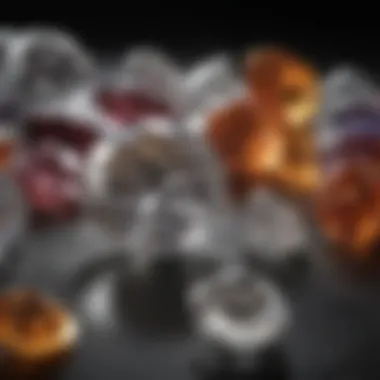
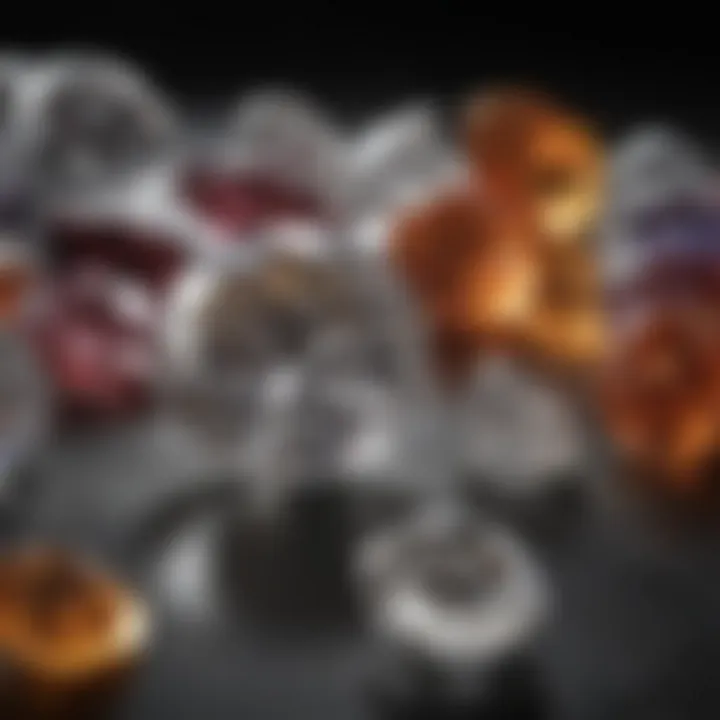
Misconceptions about Ji1 diamonds are like weeds in a garden; they can spread quickly and choke the genuine appreciation for these remarkable gems. It is important to sift through the misinformation as it not only affects the understanding of these diamonds but also impacts market behavior and consumer trust. Understanding these myths helps enthusiasts and collectors make informed decisions, which is crucial in such a nuanced domain.
Debunking Myths
One of the most prevalent myths is that Ji1 diamonds are just another name for lower-quality diamonds. This couldn’t be further from the truth. Ji1 diamonds are distinguished by their unique characteristics that set them apart from other diamonds. They are not inferior but rather a specific classification with their own set of standards. In fact, the name itself conveys a level of trust and quality recognition within specialist circles.
Another common misconception involves the belief that Ji1 diamonds are exclusively available through specialized retailers, making them less accessible than other diamond types. Many potential buyers may think that because Ji1 diamonds carry a specific label, they are confined to jewelry stores that only cater to high-end clientele. This thinking can deter some gem enthusiasts from exploring them. However, with the rise of online jewelry platforms, Ji1 diamonds are becoming more available to a broader audience. Exploring diverse marketplaces can yield options that suit various budgets, contradicting the myth of exclusivity.
Considering these points, it becomes clear that understanding the reality behind Ji1 diamonds is crucial for anyone interested in this sector. By debunking these myths, prospective buyers can better appreciate the value and significance of Ji1 diamonds.
Understanding Market Supplications
It’s also necessary to grasp how market dynamics and external influences can affect perceptions of Ji1 diamonds. Some believe that the rarity of Ji1 diamonds directly correlates with their cost. This isn’t a blanket rule. For example, a well-cut Ji1 diamond with outstanding clarity can command a higher price, but its availability on the market might surprise many.
As for supply, markets fluctuate based on consumer demand, global events, and even fashion trends. The misconception that they are in short supply often leads enthusiasts to think they have to jump at inflated prices when, in reality, strategic buying during certain periods can yield better deals. Educating oneself on market trends and patterns can be invaluable.
Moreover, differentiating between real supply issues and speculative marketing practices can help buyers avoid the pitfalls of overpaying simply due to hype. Engaging with knowledgeable communities on platforms like Reddit or Facebook can provide insights and firsthand experiences that dispel myths about supply and demand, making them more tangible.
The Future of Ji1 Diamonds
The future of Ji1 diamonds is a topic that sparks both intrigue and analysis among collectors and enthusiasts alike. Changes in technological advancements, shifting market demands, and evolving consumer values all intertwine to define what lies ahead for these exquisite gemstones. As we look toward the future, a close inspection of emerging trends and expectations for market growth becomes vital.
Emerging Trends in Gemology
The field of gemology is continuously evolving, and Ji1 diamonds are at the forefront of this transformation. One trend gaining traction is the increasing popularity of lab-grown diamonds. Unlike their naturally mined counterparts, these diamonds are crafted in controlled environments, providing a sustainable alternative that often appeals to a younger demographic. As awareness of sustainable practices rises, consumers are gravitating towards diamonds that promise both beauty and ethical sourcing.
Lab-grown Ji1 diamonds present an attractive proposition as they typically exhibit fewer imperfections and often at a more favorable price point. This allows aspiring buyers to acquire larger stones that may be out of reach in the natural segment. However, understanding the distinctions in value between natural and lab-created diamonds is paramount for collectors who aim to maintain the authenticity of their collections.
Another emerging trend relates to the personalization of diamond jewelry. People now seek to create distinct pieces that reflect their tastes and stories. Customization in cuts, settings, and designs invites potential buyers to engage more deeply with their selections. This push towards tailored jewelry indicates a shift from traditional purchasing patterns toward a more individualized experience.
"As we forecast the evolution of Ji1 diamonds, innovation in creation and personalization will undoubtedly shape the next era of gemstone appreciation."
Predictions for Market Growth
With advancements in technology and changes in consumer attitudes, the Ji1 diamond market is poised for significant growth. Analysts predict that the demand for these diamonds will elevate not only because of aesthetic appeal but also due to increased awareness of responsible sourcing.
Several factors contribute to optimistic market predictions:
- Increased Consumer Education: Today’s buyers are more informed about the qualities of Ji1 diamonds compared to years past. Awareness campaigns that demystify the grading process and educate on sourcing are vital contributors to this knowledge base.
- Integration of Technology: The diamond industry is harnessing technology in ways never imagined before. From virtual try-ons to augmented reality experiences, potential buyers can interact with diamonds remotely, thus expanding the potential market reach.
- Global Market Expansion: Emerging markets in Asia and Africa are witnessing a surge in interest in diamond jewelry. With rising disposable incomes, consumers in these regions are more likely to invest in gems, further bolstering demand for Ji1 diamonds.
- Shifts in Consumer Values: People increasingly view their purchases as a means of expressing personal identity and values. As sustainability becomes a priority, diamonds that meet ethical standards are expected to flourish and hold greater value.
In summary, understanding these elements is crucial for anyone keen on investing in Ji1 diamonds. With the right foresight, stakeholders can navigate through potential challenges and capitalize on transformative opportunities that shape the landscape of diamond investment.
Ji1 Diamonds in Popular Culture
Ji1 diamonds hold a significant place in popular culture, acting as more than just luxurious adornments but also symbols that resonate deeply with concepts of love, power, and status. In films, literature, and fashion, these diamonds serve to manifest aspirations and dreams, captivating audiences and consumers alike. By examining their representation in various media, one can unravel the layers of how Ji1 diamonds contribute to cultural narratives and trends.
Representations in Film and Literature
In the world of cinema and novels, Ji1 diamonds often become focal points of narratives, conveying wealth or serving as plot devices that propel character development. For instance, films like Blood Diamond and Diamonds Are Forever delve into the complexities surrounding diamond acquisition and ownership, presenting Ji1 diamonds within moral quandaries and ethical discussions. Characters adorned with such diamonds often symbolize ultimate success, attracting admiration while simultaneously prompting serious reflections on societal values.
Moreover, literary works, from contemporary fiction to classic tales, frequently depict Ji1 diamonds as unattainable treasures. This allure reinforces their status as sought-after symbols of romance, where they represent love and commitment. In countless poetry verses and novels, the mention of diamonds, particularly Ji1 diamonds, invokes imagery of extravagant gifts that embody profound emotions. Understanding their portrayals helps to reveal the intricacies of human motivation and societal expectations surrounding wealth and commitment.
"Diamonds are a girl’s best friend" – this phrase encapsulates how deeply entrenched Ji1 diamonds are within the cultural landscape, not merely as commodities but as representations of desires and aspirations.
Influence on Fashion and Jewelry Design
The influence of Ji1 diamonds on fashion and jewelry design is paramount, guiding trends and sparking creativity among designers. Their brilliance and rarity inspire collections that range from understated elegance to opulent extravagance. Renowned houses such as Tiffany & Co. and Cartier often incorporate Ji1 diamonds into their designs, crafting pieces that tell a story or evoke a specific emotion.
Furthermore, the rise of social media has amplified their presence. Influencers showcasing Ji1 diamonds in their jewelry collections create aspirational content that shapes consumer behaviors. Instagram and Pinterest are flooded with posts featuring these diamonds, further solidifying their status as a must-have item among fashion-forward individuals.
The unique characteristics of Ji1 diamonds, including their clarity and cut, allow designers to play with various styles, from classic solitaires to intricate pieces adorned with multiple stones. This versatility ensures that Ji1 diamonds remain at the forefront of both high fashion and accessible jewelry, appealing to a wide range of consumers seeking to make a statement.
As society evolves, so does the portrayal of Ji1 diamonds, making them not just a relic of luxury but a canvas for self-expression and cultural commentary.
Resources for Ji1 Diamond Enthusiasts
The realm of Ji1 diamonds can sometimes seem daunting, especially for newcomers or even seasoned collectors who might be navigating new trends and information. Having the right resources at hand is crucial for deepening one's understanding and appreciation of these unique gemstones. This section aims to provide valuable insight into various avenues where enthusiasts can enhance their knowledge and connect with like-minded individuals.
Books and Publications
Books and printed materials offer a great foundation for anyone looking to delve into Ji1 diamonds. They provide in-depth coverage of scientific, historical, and cultural aspects. Here are some types of books that would be particularly beneficial:
- Gemology Textbooks: These are ideal for understanding the technical nitty-gritty of gemstones. Titles like "Gemstones: Properties, Identification, and Use" often include sections specifically detailing diamonds, including Ji1 classifications.
- Coffee Table Books: Beautifully illustrated, these books not only inspire but also educate. They showcase famous Ji1 diamonds, discuss their cultural significance, and detail resulting designs in jewelry.
- Industry Guides: Publications by gemologists and jewelers can offer insights into market trends, ensuring you stay ahead of the curve when it comes to buying or selling Ji1 diamonds.
Besides books, subscribing to specialized magazines such as "National Jeweler" or "JCK" can keep you updated with the latest news and developments in the diamond market and technologies.
Online Communities and Forums
The digital age has ushered in various online platforms where enthusiasts can share knowledge, discuss trends, and gain support. Participating in these communities can be invaluable for enhancing your understanding and appreciation of Ji1 diamonds:
- Reddit: Subreddits like r/diamonds often have dialogues about Ji1 diamonds, offering a mix of technical advice and personal experiences from members. You'll find a range of discussions, from sourcing to cutting styles, all valuable for the beginner and the expert alike.
- Facebook Groups: Several dedicated groups focus on diamond enthusiasts. These platforms often have discussions about current trends, personal collections, and even ethical considerations in sourcing, providing a well-rounded perspective.
- Online Forums: Websites devoted to gemology include forums where questions can be posted and experts will reply. Engaging in these discussions can provide you with insider knowledge linking Ji1 diamonds to broader geological concepts as well.
Engaging with books and online communities not only enhances one’s personal understanding but also fosters connections that can lead to valuable learning experiences.
By tapping into these resources, whether you are a budding collector, a jewelry designer, or simply a gemology aficionado, you can navigate the fascinating world of Ji1 diamonds with more confidence and insight.
End
Recognizing the significance of Ji1 diamonds within the broader context of gemstones is paramount for collectors, jewelry designers, and geology aficionados. This conclusion serves not merely as a final note but as a summation of the values these diamonds encapsulate across various domains—be it their unique properties, ethical sourcing, or the recent technological advancements influencing their market.
First and foremost, Ji1 diamonds stand out due to their distinct chemical and physical properties. Their unique structural formations and clarity enable them to sparkle with an unparalleled brilliance that captures the interest of many. These attributes provide not only aesthetic pleasure but also contribute significantly to their investment value. In the realm of gemstones, where the balance between beauty and worth is often scrutinized, Ji1 diamonds represent a sound choice for those looking to invest wisely.
Moreover, as the article discussed, the processes of sourcing Ji1 diamonds highlight critical ethical considerations. In today’s world, where consumers are becoming more conscious about the origins of their purchases, understanding what comprises a conflict-free, ethically sourced diamond has become more than a passing trend. It’s a necessary consideration for modern buyers. By prioritizing sustainable practices, the industry not only preserves the rich history tied to these stones but also ensures their longevity in the marketplace.
The cultural significance laden within Ji1 diamonds also cannot be overstated. From their historical ties to royal legitimacy and status symbolization to their representation in popular culture, they embody more than just a commodity. They are entwined in human stories, making each diamond a piece of art with its very own history.
A focus on the future of Ji1 diamonds reveals emerging trends that could reshape their landscape yet again. As advancements in technology continue to innovate within the realms of both natural and lab-grown diamonds, understanding these shifts will be essential for anyone wishing to remain informed in the market.
"Diamonds are not just stones; they are part of the human experience, tying generations and cultures together."



